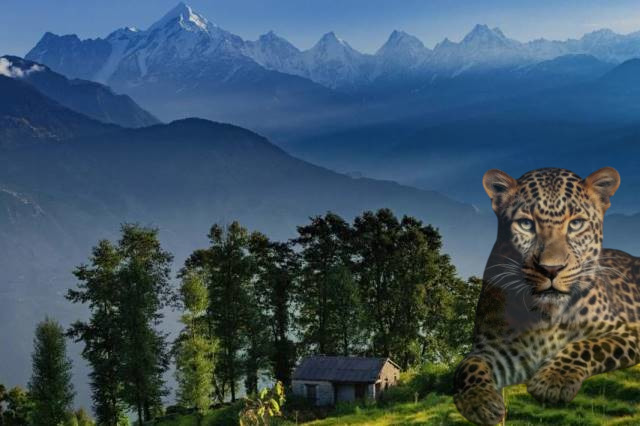
Where Life Must Go on, Like a Stream in the Hills
This fear is tangible, though the mountain sunshine has spread like mountain sunshine — sharp, soothing, serene and sensuous. It’s as tangible as the rustling of the leaves, the falling of the branches, and the lingering sound of thick, animate, forest shadows. It’s a feeling you can touch, like the sound of the rippling mountain stream down below, day and night, a romantic melody during the day, a loud lullaby in the dark, stark, silence of the night. However, these days, fear stalks a small, brave, beautiful, good-hearted, hardworking village in the Himalayan foothills — but life goes on. Life must go on.
Three dogs killed or taken by leopards in just about one year. It’s called baghera in these dense forest villages in the hills. Like everywhere, be in the suburbs of Mumbai, or the small towns of Tehri Garhwal, they stalk human civilization as predators looking for easy food. Dogs have been their eternal prey, in case they can’t get hold of a goat or sheep. This is because the mountain dogs are free creatures, they roam around in the lanes and by-lanes of the villages and the forests, and they chase the monkeys and pigs which arrive like monsters to ravage the crops. Hence, like alarm calls of the barking deer which warns of a tiger in the core area of national parks, the monkeys arrive here with the baghera in the shadows of the green undergrowth – waiting for the dogs.
There are villages in Garhwal, surrounded by huge water bodies due to the big dam, and endless expanse of forests – a direct consequence of the Chipko movement – where there are no dogs, not even one! The last one has been picked up by a leopard, hence, the village folks are compelled not to keep pets. The forests surrounding the villages are full of leopards, and, thankfully, a flourishing prey base – but dogs are the first and final casualty.
You can talk to a stoic and calm Garhwali who lives on the edge of a hill facing vast tracts of valley and forest. He would say, nonchalantly, “This morning, a couple of leopards were sitting in our verandah. So my wife and I could not come out of the house. Look here, they were sitting right under this galgal (huge yellow fruits belonging to the orange family) tree under the sun. One of them lives near that temple below. Two others come down from the hills, near one of the streams, at the bend of the road. Another couple seems to have made my house and the surrounding area its home. They simply refuse to move. On Diwali night, I started early from work on my scooty. But I had to wait a long time, all alone in the dark at a distance from my house, because this couple simply refused to move.”
And, yet, it is peaceful-coexistence here, as it is in all forests where indigenous communities, including adivasis, have lived for centuries, sharing time, space, geography and habitat with wild animals. No human has been harmed — mostly. And a 90-year old sturdy mountain woman, armed with nothing but a tall lathi, wooden staff, can take her flock of sheep or goats all alone in the thick of the forest with not an iota of fear in her heart.
However, the death and disappearance of three loving dogs is a simmering tragedy in this little village with less than ten houses, where little girls go to schools in the neighbourhood, sometimes crossing the forest. Others walk long distance to the nearest town through the zigzag of the forest. Another man runs an aata chakki propelled by a small and strong waterfall in the heart of the forest.
The line between home and the forest is thick. So, a wall has been built now by a family, because their main door would open into the street and the forest, and their two little daughters should be safe. People are shutting their doors early in the evening, not venturing to come out after the dark, guarding their children and animals with extra care and protection. A woman heard the leopard three nights ago in the vicinity of her open-to-sky courtyard. Someone saw its paws at the river bed. Two little shops in one corner still choose to be open till late after evening, their lights twinkling in the cold darkness of night, their soft whispers heard from a long distance. The predator is around.
In the night, sometimes, the forest wind blows with a theatrical flourish, full of song and drama. It’s like the Bengali jatra enacted as theatre during Kalboishaki in Bengal, when there is great thunder and lightning, and the air is thick with the erotic aroma of moist earth and nature, but rain refuses to arrive! Here, in the expanse of the Himalayas, where meadows move into woods, and woods into shadowy, hidden secrets, you can actually touch the sound of the wind; sometimes, it acquires such intense ferocity that it seems apocalyptic! It will blow your mind!
The trees swing and move and sway, as if stricken by infinite longing, intoxicated with unrequited and unfulfilled passion, and the vermillion sky in the blue horizon, soaked with anticipated rain, suddenly becomes luminescent, as if bending down to embrace the wind. It’s like a drunk sea tide riding high on a full moon night, wanting to touch the moon.
Then rain arrives — magical. And there is no understatement about it. In torrential madness, like gigantic waterfalls on the way to Gaumukh, the orgin of Ganga, the mountain river still young, primordial, pulsating, and sensational. This rain is different here from the equally dramatic rain which falls eternally during the monsoon in Kerala; like in the town of Macondo, with all doors painted blue, in the magic realism epical, One Hundred Years of Solitude by Gabriel Garcia Marquez.
ALSO READ: Breaking Bread With Tribal, Around A Sublime Fire
The Himalayan rains carry the transparent fragrance of bark, leaves, petals, fragile rocks, fungus, rotting plants and leaves, ancient trees and roots, thick foliage and strange substances, and earth, which anchors and holds all together. On the tin shed, on ledges, across the fences, in the mustard flower fields, the rain lashes like an incredible Santana drum orchestra in ‘Woodstock’. The sound reaches a crescendo, subsides, and moves, yet again, in high pitch, to and fro, like a trained classical musician playing with traditional, primitive drums. Inside mud, wood and stone homes, therefore, warm and cosy, everyone huddles together to hear a folk tale over a cup of hot tea, or sit around the kitchen fire to have a simple, hot, pahari meal.
And sleep arrives like a childhood dream, full of candy flowers, ghost stories, forgotten songs and poetry, and the smell of old cotton clothes, still, perhaps, hiding a faint memory of lavender. A familiar, loved memory. A soft, sensuous longing. A lingering, hidden, angst. A joyful moment of rapture.
In the morning, the mountain sunshine arrives like mountain sunshine. The mountain stream is rippling in its eternal journey through civilization. The villagers are collecting grass and wood, tending to their cattle, nourishing their vegetables in the garden and the crops in the fields. The kids with their rosy cheeks are going to school with their backpacks. And the dogs are out there, free and happy as ever, running here and there, looking at you with their soulful eyes, waiting for the monkeys to arrive.
For more details visit us: https://lokmarg.com/
Wonderful insights. I know this fear and have seen it in the locals too whenever I have visited my in-laws house in Uttarakhand, people don’t go out after 8 in the night. The pets are kept safely inside. There is a prevailing fear of bagh (leopard) still. I was scared too and stayed indoors during my visit last year to Batrojkhan.



